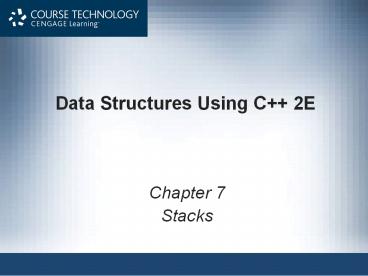Data Structures Using C 2E - PowerPoint PPT Presentation
Title:
Data Structures Using C 2E
Description:
Data Structures Using C++ 2E Chapter 7 Stacks – PowerPoint PPT presentation
Number of Views:377
Avg rating:3.0/5.0
Title: Data Structures Using C 2E
1
Data Structures Using C 2E
- Chapter 7
- Stacks
2
Objectives
- Learn about stacks
- Examine various stack operations
- Learn how to implement a stack as an array
- Learn how to implement a stack as a linked list
- Discover stack applications
- Learn how to use a stack to remove recursion
3
Stacks
- Data structure
- Elements added, removed from one end only
- Last In First Out (LIFO)
4
Stacks (contd.)
- push operation
- Add element onto the stack
- top operation
- Retrieve top element of the stack
- pop operation
- Remove top element from the stack
5
Stacks (contd.)
6
Stacks (contd.)
- Stack element removal
- Occurs only if something is in the stack
- Stack element added only if room available
- isFullStack operation
- Checks for full stack
- isEmptyStack operation
- Checks for empty stack
- initializeStack operation
- Initializes stack to an empty state
7
Stacks (contd.)
- Review code on page 398
- Illustrates class specifying basic stack
operations
8
Implementation of Stacks as Arrays
- First stack element
- Put in first array slot
- Second stack element
- Put in second array slot, and so on
- Top of stack
- Index of last element added to stack
- Stack element accessed only through the top
- Problem array is a random access data structure
- Solution use another variable (stackTop)
- Keeps track of the top position of the array
9
Implementation of Stacks as Arrays (contd.)
- Review code on page 400
- Illustrates basic operations on a stack as an
array
10
Implementation of Stacks as Arrays (contd.)
11
Initialize Stack
- Value of stackTop if stack empty
- Set stackTop to zero to initialize the stack
- Definition of function initializeStack
12
Empty Stack
- Value of stackTop indicates if stack empty
- If stackTop zero stack empty
- Otherwise stack not empty
- Definition of function isEmptyStack
13
Full Stack
- Stack full
- If stackTop is equal to maxStackSize
- Definition of function isFullStack
14
Push
- Two-step process
- Store newItem in array component indicated by
stackTop - Increment stackTop
15
Push (contd.)
- Definition of push operation
16
Return the Top Element
- Definition of top operation
17
Pop
- Remove (pop) element from stack
- Decrement stackTop by one
18
Pop (contd.)
- Definition of pop operation
- Underflow
- Removing an item from an empty stack
- Check within pop operation (see below)
- Check before calling function pop
19
Copy Stack
- Definition of function copyStack
20
Constructor and Destructor
21
Copy Constructor
- Definition of the copy constructor
22
Overloading the Assignment Operator ()
- Classes with pointer member variables
- Assignment operator must be explicitly overloaded
- Function definition to overload assignment
operator for class stackType
23
Stack Header File
- myStack.h
- Header file name containing class stackType
definition
24
Stack Header File (contd.)
- Stack operations analysis
- Similar to class arrayListType operations
25
Linked Implementation of Stacks
- Disadvantage of array (linear) stack
representation - Fixed number of elements can be pushed onto stack
- Solution
- Use pointer variables to dynamically allocate,
deallocate memory - Use linked list to dynamically organize data
- Value of stackTop linear representation
- Indicates number of elements in the stack
- Gives index of the array
- Value of stackTop 1
- Points to top item in the stack
26
Linked Implementation of Stacks (contd.)
- Value of stackTop linked representation
- Locates top element in the stack
- Gives address (memory location) of the top
element of the stack - Review program on page 415
- Class specifying basic operation on a stack as a
linked list
27
Linked Implementation of Stacks (contd.)
- Example 7-2
- Stack object of type linkedStackType
28
Default Constructor
- When stack object declared
- Initializes stack to an empty state
- Sets stackTop to NULL
- Definition of the default constructor
29
Empty Stack and Full Stack
- Stack empty if stackTop is NULL
- Stack never full
- Element memory allocated/deallocated dynamically
- Function isFullStack always returns false value
30
Initialize Stack
- Reinitializes stack to an empty state
- Because stack might contain elements and you are
using a linked implementation of a stack - Must deallocate memory occupied by the stack
elements, set stackTop to NULL - Definition of the initializeStack function
31
Initialize Stack (contd.)
32
Push
- newElement added at the beginning of the linked
list pointed to by stackTop - Value of pointer stackTop updated
33
Push (contd.)
34
Push (contd.)
- Definition of the push function
35
Return the Top Element
- Returns information of the node to which stackTop
pointing - Definition of the top function
36
Pop
- Removes top element of the stack
- Node pointed to by stackTop removed
- Value of pointer stackTop updated
37
Pop (contd.)
38
Pop (contd.)
- Definition of the pop function
39
Copy Stack
- Makes an identical copy of a stack
- Definition similar to the definition of copyList
for linked lists - Definition of the copyStack function
40
(No Transcript)
41
Constructors and Destructors
- Definition of the functions to implement the copy
constructor and the destructor
42
Overloading the Assignment Operator ()
- Definition of the functions to overload the
assignment operator
43
Overloading the Assignment Operator () (contd.)
44
Stack as Derived from the class
unorderedLinkedList
- Stack push function, list insertFirst function
- Similar algorithms
- initializeStack and initializeList, isEmptyList
and isEmptyStack, etc. - Shows that class linkedStackType is derived from
class linkedListType - Functions pop and isFullStack implemented for
linked stack - class linkedListType abstract class
- class unorderedLinkedListType derived from class
linkedListType
45
Application of Stacks Postfix Expressions
Calculator
- Arithmetic notations
- Infix notation operator between operands
- Prefix (Polish) notation operator precedes
operands - Reverse Polish notation operator follows
operands - Stack use in compliers
- Translate infix expressions into some form of
postfix notation - Translate postfix expression into machine code
46
Application of Stacks Postfix Expressions
Calculator (contd.)
- Postfix expression 6 3 2
47
Application of Stacks Postfix Expressions
Calculator (contd.)
- Main algorithm pseudocode
- Broken into four functions for simplicity
- Function evaluateExpression
- Function evaluateOpr
- Function discardExp
- Function printResult
48
Removing Recursion Nonrecursive Algorithm to
Print a Linked List Backward
- Stack
- Used to design nonrecursive algorithm
- Print a linked list backward
- Use linked implementation of stack
49
(No Transcript)
50
(No Transcript)
51
STL class stack
- Standard Template Library (STL) library class
defining a stack - Header file containing class stack definition
- stack
52
Summary
- Stack
- Last In First Out (LIFO) data structure
- Implemented as array or linked list
- Arrays limited number of elements
- Linked lists allow dynamic element addition
- Stack use in compliers
- Translate infix expressions into some form of
postfix notation - Translate postfix expression into machine code
- Standard Template Library (STL)
- Provides a class to implement a stack in a program





























![Data Structures [1] PowerPoint PPT Presentation](https://s3.amazonaws.com/images.powershow.com/7170786.th0.jpg?_=20150917062)

